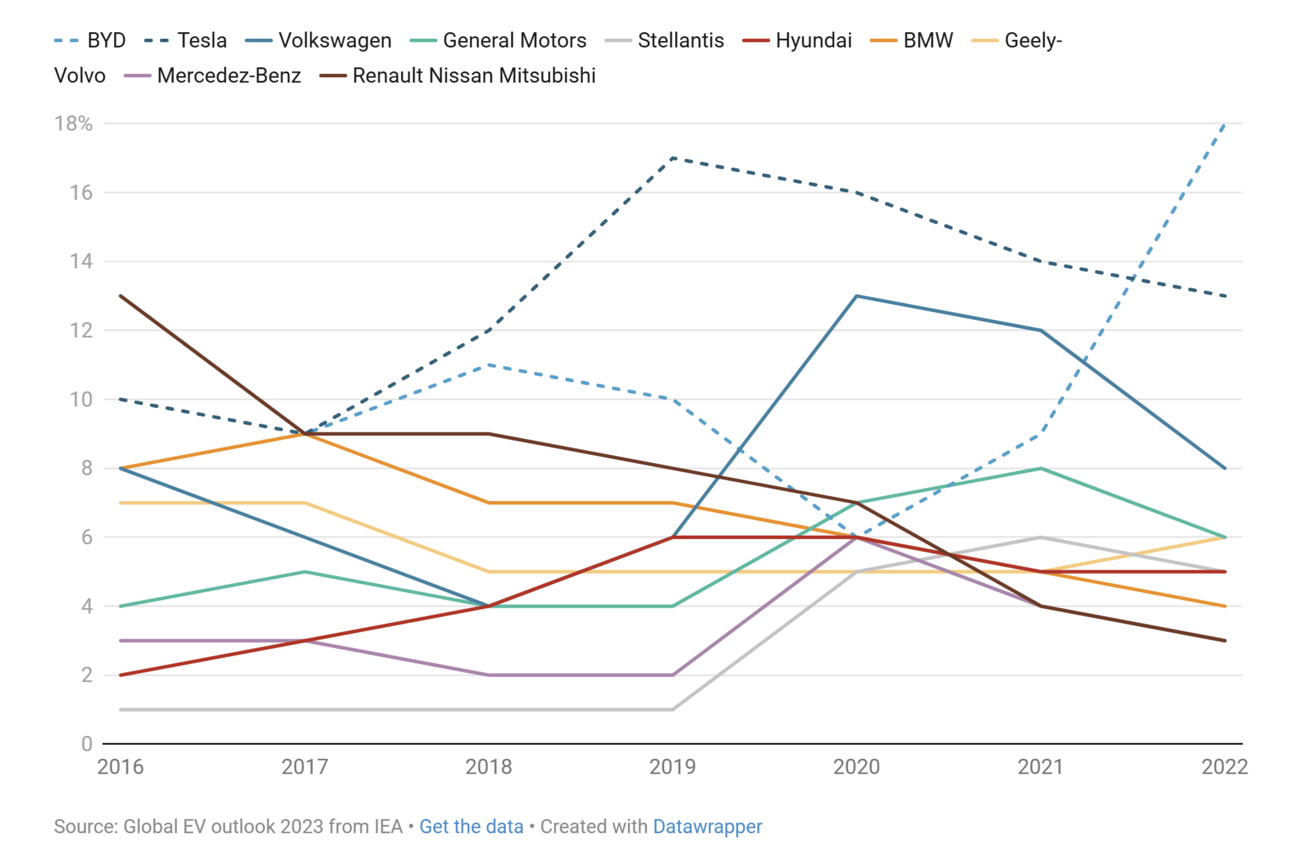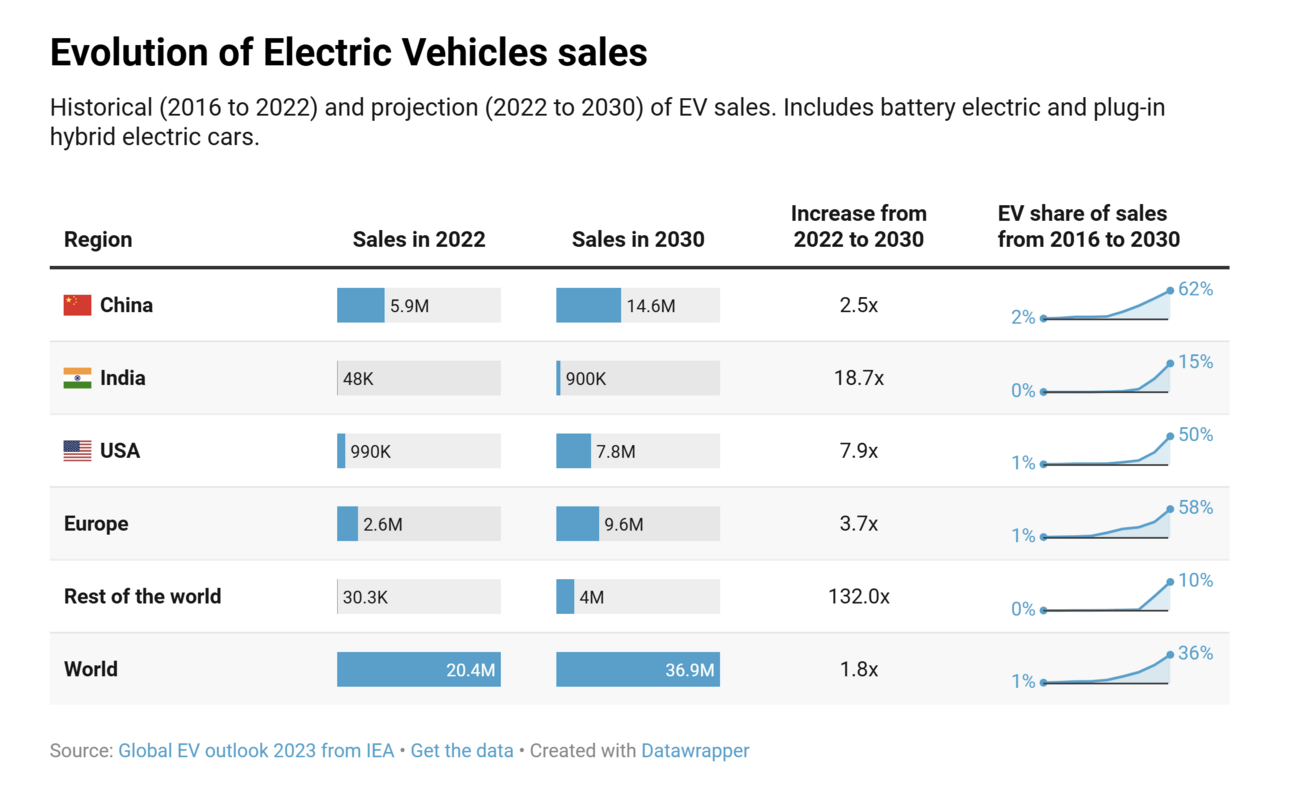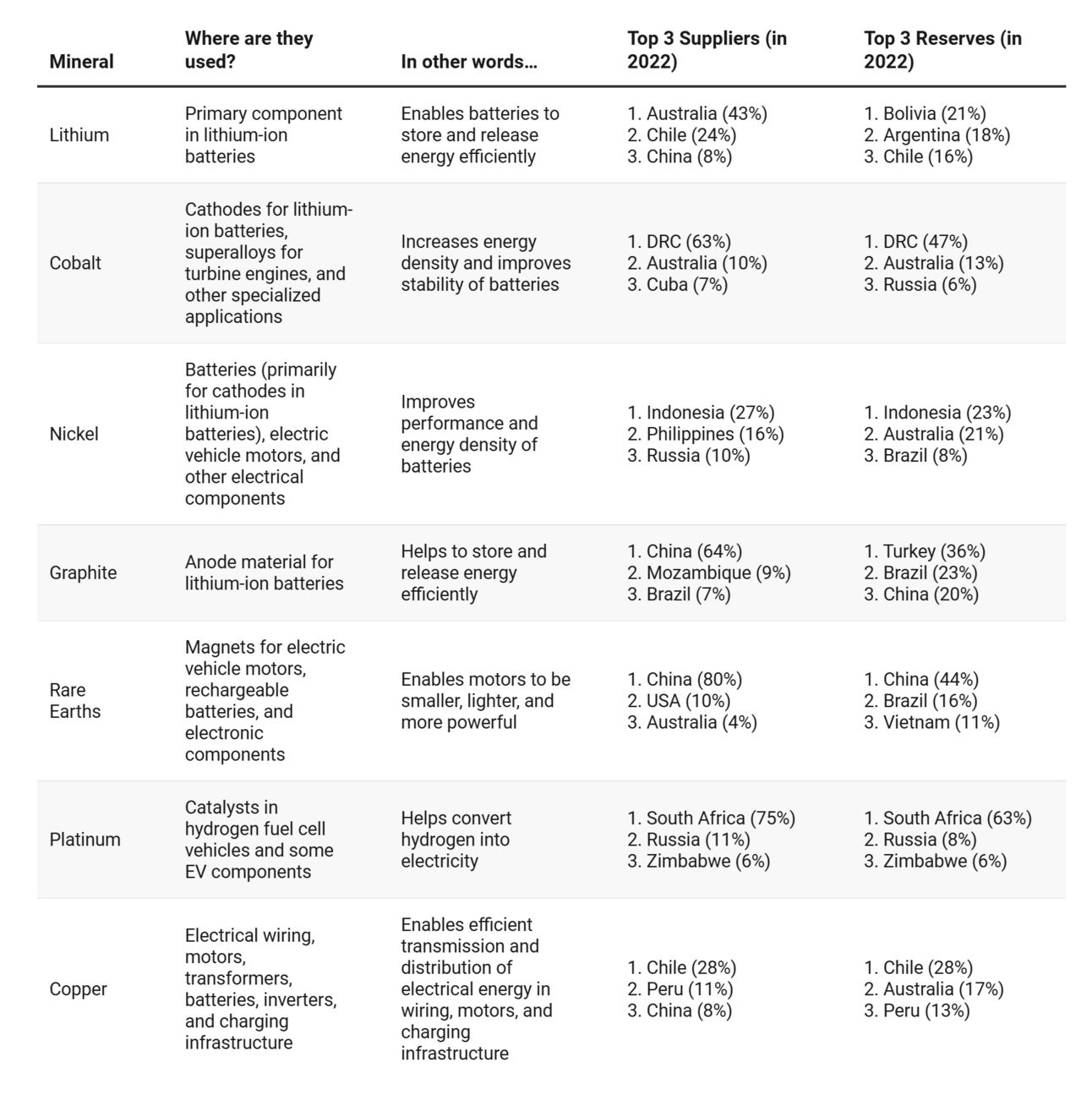- Per My Last Thought
- Posts
- Could Minerals Essential for EVs Ignite Future Conflicts?
Could Minerals Essential for EVs Ignite Future Conflicts?
The push for electric vehicles has intensified demand for critical minerals like lithium and cobalt. This article examines how rarity, uneven distribution, and strategic importance may escalate territorial disputes and global supply-security risks.
As the drive for global sustainability intensifies, one critical objective is reducing hydrocarbon use in the automotive industry, which accounts for 14% of worldwide oil consumption and CO2 emissions. Over the last decade, Tesla has led the charge in this mission, disrupting the Electric Vehicles (EVs) industry and challenging traditional automakers such as BYD and Volkswagen to double down on the rising market demand of EVs — the greener automotive alternatives.

By 2030, it’s predicted that EVs will make up over 50% of the US and 35% of the global automotive share of sales, a significant jump from today’s 7% in the US and 14% globally, and less than 1% in 2016.

To support this shift, G20 governments are implementing various strategies. These include a mix of regulatory measures and incentives to encourage automakers to broaden their EV lines, cap the production and sale of combustion engine vehicles, motivate consumers to opt for more cost-effective and eco-friendly electric vehicles, and provide the required charging station infrastructure.
A Myriad of challenges in the Transition to EVs
The increasing adoption of electric vehicles (EVs) presents a promising opportunity to reduce reliance in the transportation sector on oil and gas, a major source of carbon emissions, while shifting towards cleaner energy sources. However, transitioning to EVs and ensuring their long-term sustainability involves overcoming several challenges.
One such challenge is the finite and concentrated availability of many key minerals like lithium, cobalt, and nickel, which are crucial for battery production. This issue is further compounded by the concentration of essential mineral deposits in specific regions, leading to potential imbalances and dependencies on certain countries.
Another obstacle is the expansion of charging stations and infrastructure to accommodate the growing number of EVs and to make it accessible for all users. Integrating EVs into power grids requires also addressing peak demand and investing in grid upgrades to manage increased electricity consumption — ideally using clean energy to help minimize carbon emissions.
Minimizing waste and resource depletion is also a concern that depends on the adequate management of end-of-life batteries and developing efficient recycling processes. Other, more direct environmental impacts of EVs can also include habitat destruction, water pollution, and increased carbon emissions from mining activities.
Spotlight on the geopolitical risks of EVs
In this brief article, I aim to share my thoughts and concerns about the potential geopolitical risks that may arise from the ongoing surge in electric vehicle (EV) adoption and the displacement of traditional combustion engines. The industry’s dependence on specific minerals and rare earth elements presents challenges due to the scarcity and regional concentration of some of these materials. This concentration makes the industry vulnerable to supply chain disruptions, which must be carefully managed to ensure the sustainable growth of the EV market. Some examples of such minerals include lithium from the South American countries of Bolivia, Argentina, and Chile; cobalt from the Democratic Republic of Congo (DRC); and rare earths from China and Brazil. These raw materials are concentrated within developing economies, particularly in BRICS countries (Brazil, Russia, India, China, and South Africa). The BRICS countries are emerging market economies forming a strengthening global economic alliance, with a clear intent to challenge the current world order.

If the EV industry continues to grow, future geopolitical conflicts over essential materials could become a reality including rise in poverty and abuse of mineral-rich countries, posing risks to the entire sector. The potential victims are mainly underdeveloped and politically unstable countries with significant mineral resources, such as the DRC, which is one of the world’s richest sources of cobalt and other minerals, yet has an extremely poor population and an underdeveloped economy. The DRC is no stranger to global influence and control over its natural resources, which has been a main root cause of its dark past of abuse and slavery. With the rising EV trend, demand for cobalt is expected to increase by up to 40 times by 2040, which could be catastrophic for the DRC, which supplies over 60% of the global cobalt and has half of the current world reserves if managed inappropriately.
The extraction of lithium in countries like Chile has not been without challenge either, as mining operations have raised concerns about water scarcity, habitat destruction, and social impacts on local communities. Recognizing the need for greater control and responsibility, the government of Chile has taken steps to protect its economy and population by nationalizing its lithium industry, through which the government aims to assert greater oversight, regulate mining practices, hoping to strike a balance between economic development and environmental sustainability, mitigating the negative impacts associated with lithium mining and fostering a more inclusive and responsible approach to resource utilization.
Moreover, as demand for these materials rises, global powers will be exposed to supply chain risks, which could hamper their technological supremacy. A relevant example of supply chain risk can be observed in the semiconductor industry, where escalating tensions between China and Taiwan have heightened concerns. These tensions have prompted many tech giants to seek alternatives to avoid a supply squeeze in case of future altercations in Asia and major investors such as Warren Buffet to sell his Berkshire Hathaway shares in the Taiwan-based multinational TSMC (Taiwan Semiconductor Manufacturing Company) fearing escalating geopolitical risks.
I don’t want my brief write-up to sound like all doom and gloom. There are indeed advancements in battery technology that show promise in reducing our dependence on minerals like cobalt. For example, solid-state battery packs and innovations aimed at phasing out cobalt from lithium-ion batteries are technological advancement that could help reduce demand-load of critical minerals. Moreover, the transition to EVs carries numerous other benefits across sustainable development, job creation, and the emergence of new industries and economic opportunities.
Wrap-up
However, as the world journeys towards a greener future, will minerals and rare earth elements become the focal point of geopolitical disputes, much like oil and other commodities have been in the past? Will international forums and organizations such as the United Nations, G20, and International Energy Agency (IEA) play a significant role in fostering dialogue and cooperation among nations on this topic? Will companies and leading industry players dependent on the supply of minerals such as cobalt or lithium approach this transition conscientiously, giving back and helping to develop vulnerable major supply sources like the DRC?
Sources supporting this article:
· Bloomberg: “ US Goes on the Offensive in Its China Tech War” (Semiconductor supply chain risks): https://www.bloomberg.com/news/newsletters/2022-08-13/us-goes-on-offense-in-china-tech-war-new-economy-saturday
· Cobalt Red: How the Blood of the Congo Powers Our Lives by Siddharth Kara (2023)
· Financial Times: “The Geopolitics of Electric Cars” (Geopolitical risks and dependencies): https://www.ft.com/content/eb23bec8-5ce6-11e8-9334-2218e7146b04
· International Energy Agency (IEA): https://www.iea.org/reports/global-ev-outlook-2021
· IEA: “Global EV Outlook 2023” (Global and US market share projections): https://www.iea.org/reports/global-ev-outlook-2023
· Our World in Data: “Transport: Global Carbon Emissions” (CO2 emissions and oil consumption): https://ourworldindata.org/co2-emissions-from-transport
· U.S. Energy Information Administration (EIA): https://www.eia.gov/outlooks/ieo/pdf/transportation.pdf
· U.S. Environmental Protection Agency (EPA): https://www.epa.gov/transportation-air-pollution-and-climate-change/carbon-pollution-transportation
· US Geological Survey: “Mineral Commodity Summaries 2021” (Minerals and rare earth elements): https://pubs.usgs.gov/periodicals/mcs2023/mcs2023.pdf
· World Bank: “The Growing Role of Minerals and Metals for a Low Carbon Future” (Minerals and metals for EVs): http://documents.worldbank.org/curated/en/207371500386458722/pdf/117581-WP-P159838-PUBLIC-ClimateSmartMiningJuly.pdf
Subscribe to DDIntel Here.
Visit our website here: https://www.datadriveninvestor.com
Join our network here: https://datadriveninvestor.com/collaborate
Could Minerals Essential for EVs Ignite Future Conflicts? was originally published in DataDrivenInvestor on Medium, where people are continuing the conversation by highlighting and responding to this story.